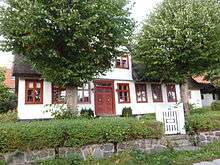Bondebyen

Bondebyen (Pesants' Town in Danish) is a historical neighbourhood of Kongens Lyngby. It is considered the best-preserved country town of the Copenhagen area,[1] albeit it is now in the middle of the heavily urbanized Lyngby-Taarbæk municipality.
Among the notable buildings is the house of Støvlet-Cathrine, as well as Lindegaarden (Linden Farm), built between 1841–1883.[2] Høstvej nr. 4, Vilhelminelyst, was Gyrithe Lemche's ancestral home. The known jurist Janus Kolderup-Rosenvinge lived in Høstvej nr. 6, and the merchant J. Fr. Tutein lived in Asylgade nr. 7.
The association Bondebylauget has worked since 1970 to preserve, improve and restore the area;[3] its president, Niels Friderichsen, is generally recognized to have saved Bondebyen from destruction by the buldozer-happy Lyngby-Taarbæk municipality.[4] Most of the buildings in Bondebyen are now listed.[5] [6]
References
- ↑ Poul Erik Skriver (22 June 1984). "Bondebyen i storbyen". Ingeniøren.
- ↑ "Lyngby-Taarbæk Kommune: Bondebyen". 26 April 2007.
- ↑ "Om Bondebylauget".
- ↑ Michael Bast (30 September 2008). "Gårdejeren og hans familie på Vilhelminelyst i Bondebyen". Det Grønne Område.
- ↑ Ulf Wesley Johnsen (2006). Bondebyen i billeder - en billedlig historie uden ord fra et unikt boligmiljø i hjertet af Kongens Lyngby. Idon. ISBN 87-89724-14-3.
- ↑ Lene Olesen, Niels Erik Jensen (1981). Et Stykke af Lyngby. Registrant over Bondebyens bygninger. Miljøministeriet, Fredningsstyrelsen og Lyngby-Taarbæk Kommune.
External links
- "Bondebyen". Alt om København.
- Hans Nielsen (12 December 2008). "Bondebyen - lokalplan". Bygningskultur Foreningen i Lyngby-Taarbæk.
See also
- The Open Air Museum, a collection of historical buildings that was moved to Sorgenfri, in the same municipality
- Rådvad, a similar neighbourhood, also in the same municipality, but of industrial, rather than agricultural, origin, and much more isolated
Coordinates: 55°46′30″N 12°30′13″E / 55.77500°N 12.50361°E